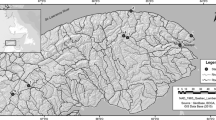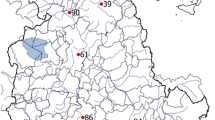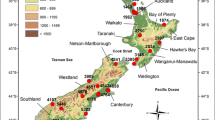Abstract
Extreme normalised residuals, defined as departures from the average values, of 65 daily maximum, T max, and minimum, T min, temperature series recorded in Catalonia (NE Spain) during 1950–2004 are analysed. Similarly to the sampling strategies applied to long dry spells, the partial duration series (PDS) offer some advantages in comparison with the annual extreme series. Instead of using a common percentile threshold for all temperature series, PDS are chosen according to the mean excess plot procedure. Series of extreme residuals are modelled, in terms of the L-moments formulation, by the generalised Pareto distribution. Extreme residuals of T max and T min are estimated for return periods ranging from 2 to 50 years and their spatial distribution is represented for selected return periods of 2, 5, 10, 25 and 50 years. Two daily extreme temperatures events, a hot episode (in August) and a cold episode (in February), are simulated taking into account the average T max (T min) for a day in August (February), their standard deviations and the extremes for a 50-year return period. Both simulations are compared with outstanding real episodes recorded on August 13th 2003 and February 11th 1956. Additionally, a spatial regionalisation of Catalonia in several clusters, in terms of the extreme residuals for return periods from 2 to 50 years, is done. A principal component analysis is applied to the extreme residual curves characterising every temperature series and, using as variables the principal components, the regionalisation is obtained by applying the average linkage clustering algorithm. Finally, each cluster is characterised by its average extreme residual curve for return periods ranging from 2 to 50 years at 1-year interval.

















Similar content being viewed by others
References
Beguería S (2005) Uncertainties in partial duration series modelling of extremes related to the choice of the threshold value. J Hydrol 303:215–230
Black E, Sutton R (2007) The influence of oceanic conditions on the hot European summer of 2003. Clim Dyn 28:53–66
Black E, Blackburn M, Harrison G, Hoskins B, Methven J (2004) Factors contributing to the summer 2003 European heatwave. Weather 59:217–223
Bryant E (1997) Climate process and change. Cambridge University Press, Cambridge, p 209
Burgueño A, Lana X, Serra C (2002) Significant hot and cold events at the Fabra Observatory, Barcelona (NE Spain). Theor Appl Climatol 71:141–156
Burt S (2004) The August 2003 heatwave in the United Kingdom: part 1—maximum temperatures and historical precedents. Weather 59:199–208
Capel JJ (2000) El clima de la Península Ibérica, Ed. Ariel, Barcelona, 281 pp
Chase TN, Wolter K, Pielke RA Sr, Rasool I (2006) Was the 2003 European summer heat wave unusual in a global context? Geophys Res Lett 33:L23709. doi:10.1029/2006GL027470
Colacino M, Conte M (1995) Heat waves in the Central Mediterranean. A synoptic climatology. Il Nuovo Cimento 18C:295–304
Coles S (2001) An introduction to statistical modeling of extreme events. Springer series in statistics. Springer, London, p 208
Essenwanger OM (1986) Elements of statistical analysis. World survey in climatology, 1B. Elsevier, Amsterdam, p 424
Ferranti L, Viterbo P (2006) The European Summer of 2003: sensitivity to soil water initial conditions. J Clim 19:3659–3679
Gázquez A, Prohom M (2003) L’estiu de 2003 a l’Observatori Fabra. Comparativa amb la sèrie 1914–2003. Penell 16:10–12
Greenwood JA, Landwehr JM, Matalas NC, Wallis JR (1979) Probability weighted moments: definition and relation to parameters of several distributions expressable in inverse form. Water Resour Res 15:1049–1054
Hirschi JJM, Sinha B (2007) Negative NAO and cold Eurasian winters: how exceptional was the winter of 1962/1963? Weather 62:43–45
Hosking JRM, Wallis JR (1997) Regional frequency analysis. An approach based on L-moments. Cambridge University Press, Cambridge, p 244
Jury MR, Parker B (1998) A cold winter over the South-African Highveld. Pattern-recognition and preliminary models. South Afr J Science 94(10):473–481
Kalkstein LS, Tang G, Skindlov JA (1987) An evaluation of three clustering procedures for use in synoptic climatological classifications. J Clim Appl Meteorol 26:717–730
Kunkel KE, Pielke RA, Changnon SA (1999) Temporal fluctuations in weather and climate extremes that cause economic and human health impacts: a review. Bull Am Meteorol Soc 80:1077–1098
Lana X, Fernández-Mills G (1994) Minimum sample size for synoptic weather type classification. Application to winter period data recorded in the Catalan coast (NE–Spain). Int J Climatol 14:1051–1060
Lana X, Martínez MD, Burgueño A, Serra C, Martín-Vide J, Gómez L (2006a) Distributions of long dry spells in the Iberian Peninsula, years 1951–1990. Int J Climatol 26:1999–2021
Lana X, Burgueño A, Martínez MD, Serra C (2006b) Statistical distribution and sampling strategies for the analysis of extreme dry spells in Catalonia (NE Spain). J Hydrol 324:94–114
Lana X, Martínez MD, Burgueño A, Serra C (2008) Statistics of hot and cold events in Catalonia (NE Spain) for the recording period 1950–2004. Theor Appl Climatol. doi:10.1007/s00704-008-0052-2
LeBoutillier DW, Waylen PR (1988) Stochastic analyses and cold spells. J Appl Meteor 27:67–76
Macchiato M, Serio C, Lapenna V, La Rotonda L (1993) Parametric time series analysis of cold and hot spells in daily temperatures: an application in Southern Italy. J Appl Meteor 32:1270–1281
Machado Trigo R, García-Herrera R, Díaz J, Franco Trigo I, Valente MA (2005) How exceptional was the early August 2003 heatwave in France? Geophys Res Lett 32:L10701. doi:10.1029/2005GL022410
Martínez MD, Serra C, Burgueño A, Lana X (2009) Time trends of daily maximum and minimum temperatures in Catalonia (NE Spain) for the period 1975–2004. Int J Climatol. doi:10.1002/joc.1884
Meehl GA, Tebaldi C (2004) More intense, more frequent and longer lasting heat waves in the 21st century. Science 305:994–997
North GR, Bell TL, Callahan RF (1982) Sampling errors in the estimation of empirical orthogonal functions. Mon Weather Rev 110:699–706
Olcina J (1994) Riesgos climáticos en la Península Ibérica. Acción Divulgativa S.L, Madrid, p 440
Preisendorfer RW (1988) Principal components analysis in climatology and meteorology. Elsevier, Amsterdam, p 425
Raso JM (1999) Temperaturas extremas y mortalidad Barcelona. In: La Climatología Española en los Albores del Siglo XXI. II Congreso de la Asociación Española de Climatología. Publicaciones de la A.E.C. A(1), 459–468
Richman MB (1986) Rotation of principal components. J Climatol 6:293–333
Schär C, Vidale PL, Lüthl D, Frei C, Häberli C, Liniger MA, Appenzeller C (2004) The role of increasing temperature variability in European summer heatwaves. Nature 427:332–336
Stott PA, Stone DA, Allen MR (2004) Human contribution to the European heatwave of 2003. Nature 432:610–614
Sutton RT, Hodson DLR (2005) Atlantic ocean-forcing of North American and European summer climate. Science 309:115–118
Trigo RM, Pereira JMC, Pereira MG, Mota B, Calado TJ, Dacamara CC, Santo FE (2006) Atmosphere conditions associated with the exceptional fire season of 2003 in Portugal. Int J Climatol 26:1741–1757
Wagner D (1999) Assessment of the probability of extreme weather events and their potential effects in large conurbations. Atmos Environ 33(24–25):4151–4155
Acknowledgements
We are indebted to the Agencia Estatal de Meteorología (Ministry of Environment, Spanish Government) and the Fabra Observatory (Reial Acadèmia de Ciències i Arts de Barcelona) who have compiled the temperature records and gently transferred the database to the authors.
Author information
Authors and Affiliations
Corresponding author
Rights and permissions
About this article
Cite this article
Serra, C., Martínez, M.D., Lana, X. et al. Extreme normalised residuals of daily temperatures in Catalonia (NE Spain): sampling strategies, return periods and clustering process. Theor Appl Climatol 101, 1–17 (2010). https://doi.org/10.1007/s00704-009-0172-3
Received:
Accepted:
Published:
Issue Date:
DOI: https://doi.org/10.1007/s00704-009-0172-3




